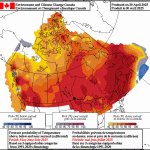weather

More stable ENSO neutral weather conditions expected for summer

Prairie forecast: Hot east, cool west
Forecast issued May 7, covering May 7 to 14, 2025

Seasonal outlook points to hot Canadian spring/summer

Prairie forecast: Here comes the summery weather
Forecast issued April 30, covering April 30 to May 7, 2025

Prairie forecast: Warm weather gaining ground
Forecast issued April 23, covering April 23 to 30, 2025

Prairie forecast: Temperature rollercoaster to continue
Forecast issued April 16, covering April 16 to 23, 2025

Prairie forecast: Warm start, unsettled weekend across extreme south
Forecast issued April 9, covering April 9 to 16, 2025

Prairie forecast: Two lows and a high
Forecast issued April 2, covering April 2 to 9, 2025

Prairie forecast: Spring storm could bring significant snow
Forecast issued March 26, covering March 26 to April 2, 2025

Transition to drought expected to be swifter this year
Fractions of a degree of change in ocean tempartures impacts weather patterns for ag producers in caring for their livestock and crops


